中西文化比较与翻译
- 格式:doc
- 大小:80.50 KB
- 文档页数:10
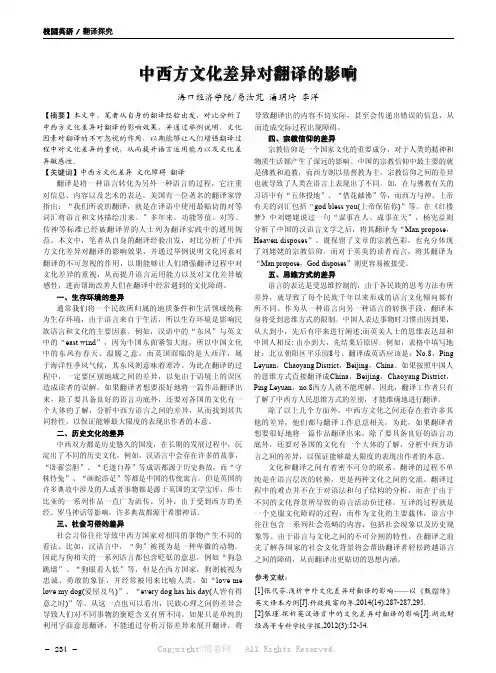
- 234 -校园英语 /翻译探究中西方文化差异对翻译的影响海口经济学院/易汝芃 潘玥琦 李洋【摘要】本文中,笔者从自身的翻译经验出发,对比分析了中西方文化差异对翻译的影响效果,并通过举例说明,文化因素对翻译的不可忽视的作用,以期能够让人们增强翻译过程中对文化差异的重视,从而提升语言运用能力以及文化差异敏感性。
【关键词】中西方文化差异 文化障碍 翻译翻译是将一种语言转化为另外一种语言的过程,它注重对信息、内容以及艺术的表达。
美国有一位著名的翻译家曾指出:“我们所说的翻译,就是在译语中使用最贴切的对等词汇将语言和文体描绘出来。
”多年来,功能等值、对等、传神等标准已经被翻译界的人士列为翻译实践中的通用规范。
本文中,笔者从自身的翻译经验出发,对比分析了中西方文化差异对翻译的影响效果,并通过举例说明文化因素对翻译的不可忽视的作用,以期能够让人们增强翻译过程中对文化差异的重视,从而提升语言运用能力以及对文化差异敏感性,进而帮助改善人们在翻译中经常遇到的文化障碍。
一、生存环境的差异通常我们将一个民族所归属的地质条件和生活领域统称为生存环境,由于语言来自于生活,所以生存环境是影响民族语言和文化的主要因素。
例如,汉语中的“东风”与英文中的“east wind ”,因为中国东面紧邻大海,所以中国文化中的东风有春天、温暖之意,而英国面临的是大西洋,属于海洋性季风气候,其东风则意味着寒冷。
为此在翻译的过程中,一定要区别地域之间的差异,以免由于语境上的误区造成读者的误解。
如果翻译者想要很好地将一篇作品翻译出来,除了要具备良好的语言功底外,还要对各国的文化有一个大体的了解,分析中西方语言之间的差异,从而找到其共同特性,以保证能够最大限度的表现出作者的本意。
二、历史文化的差异中西双方都是历史悠久的国度,在长期的发展过程中,沉淀出了不同的历史文化。
例如,汉语言中会存在许多的故事,“卧薪尝胆”、“毛遂自荐”等成语都源于历史典故,而“守株待兔”、“画蛇添足”等都是中国的传统寓言。

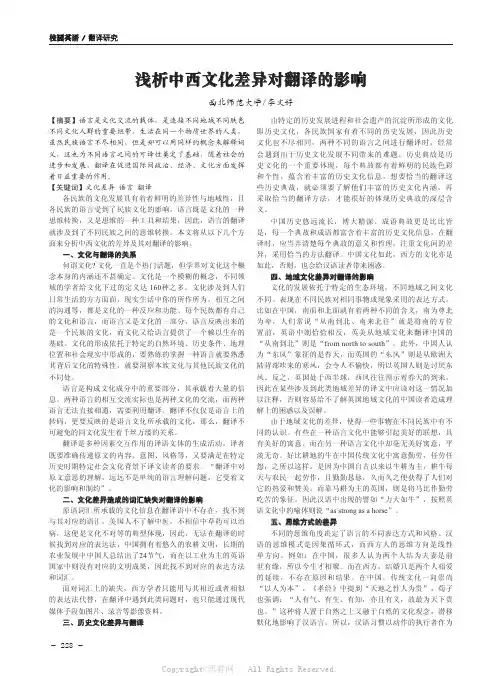
- 228-校园英语 / 翻译研究浅析中西文化差异对翻译的影响西北师范大学/李文婷【摘要】语言是文化交流的载体,是连接不同地域不同肤色不同文化人群的重要纽带,生活在同一个物质世界的人类,虽然民族语言不尽相同,但是却可以用同样的概念来解释词义,这也为不同语言之间的可译性奠定了基础,随着社会的进步和发展,翻译在促进国际间政治、经济、文化方面发挥着日益重要的作用。
【关键词】文化差异 语言 翻译各民族的文化发展具有着着鲜明的差异性与地域性,且各民族的语言受到了民族文化的影响,语言既是文化的一种思维转换,又是思维的一种工具和结果,因此,语言的翻译就涉及到了不同民族之间的思维转换。
本文将从以下几个方面来分析中西文化的差异及其对翻译的影响。
一、文化与翻译的关系何谓文化? 文化一直是个热门话题,但学界对文化这个概念本身的内涵还不甚确定。
文化是一个模糊的概念,不同领域的学者给文化下过的定义达 160种之多。
文化涉及到人们日常生活的方方面面,现实生活中你的所作所为,相互之间的沟通等,都是文化的一种反应和功能。
每个民族都有自己的文化和语言,而语言又是文化的一部分,语言反映出来的是一个民族的文化,而文化又给语言提供了一个赖以生存的基础。
文化的形成依托于特定的自然环境、历史条件、地理位置和社会现实中形成的,要熟练的掌握一种语言就要熟悉其背后文化的特殊性,就要洞察本族文化与其他民族文化的不同处。
语言是构成文化成分中的重要部分,其承载着大量的信息。
两种语言的相互交流实际也是两种文化的交流,而两种语言无法直接相通,需要利用翻译。
翻译不仅仅是语言上的转码,更要反映的是语言文化所承载的文化,那么,翻译不可避免的同文化发生着千丝万缕的关系。
翻译是多种因素交互作用的译语文体的生成活动。
译者既要准确传递原文的内容、意图、风格等,又要满足在特定历史时期特定社会文化背景下译文读者的要求。
“翻译中对原文意思的理解,远远不是单纯的语言理解问题,它受着文化的影响和制约”。
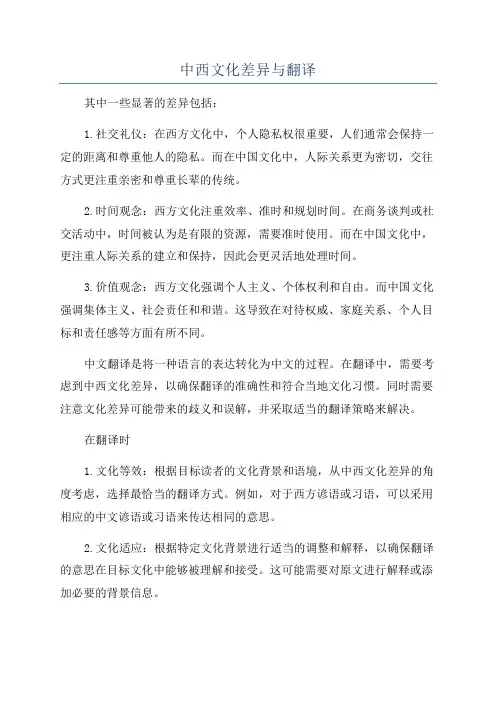
中西文化差异与翻译其中一些显著的差异包括:1.社交礼仪:在西方文化中,个人隐私权很重要,人们通常会保持一定的距离和尊重他人的隐私。
而在中国文化中,人际关系更为密切,交往方式更注重亲密和尊重长辈的传统。
2.时间观念:西方文化注重效率、准时和规划时间。
在商务谈判或社交活动中,时间被认为是有限的资源,需要准时使用。
而在中国文化中,更注重人际关系的建立和保持,因此会更灵活地处理时间。
3.价值观念:西方文化强调个人主义、个体权利和自由。
而中国文化强调集体主义、社会责任和和谐。
这导致在对待权威、家庭关系、个人目标和责任感等方面有所不同。
中文翻译是将一种语言的表达转化为中文的过程。
在翻译中,需要考虑到中西文化差异,以确保翻译的准确性和符合当地文化习惯。
同时需要注意文化差异可能带来的歧义和误解,并采取适当的翻译策略来解决。
在翻译时1.文化等效:根据目标读者的文化背景和语境,从中西文化差异的角度考虑,选择最恰当的翻译方式。
例如,对于西方谚语或习语,可以采用相应的中文谚语或习语来传达相同的意思。
2.文化适应:根据特定文化背景进行适当的调整和解释,以确保翻译的意思在目标文化中能够被理解和接受。
这可能需要对原文进行解释或添加必要的背景信息。
3.文化传达:除了简单地翻译文本,还可以尝试传达原文背后的文化意义和情感。
这需要对原文的文化内涵有深入的理解,并使用适当的语言和表达方式来传达。
总之,中西文化差异对于中文翻译来说是一个重要的考虑因素。
翻译对于准确传达原文的意思和文化背景至关重要,可以通过文化等效、文化适应和文化传达等策略来处理中西文化差异。
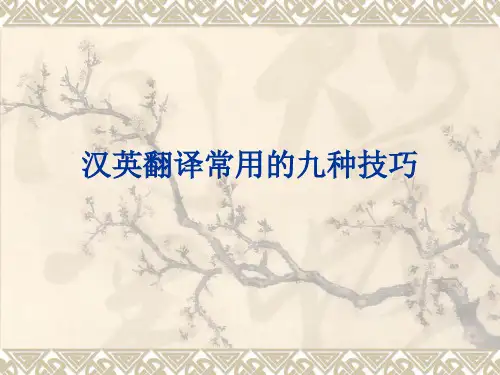
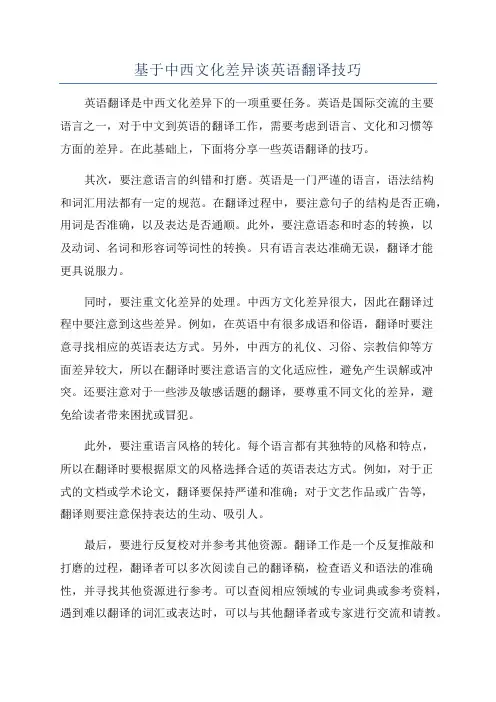
基于中西文化差异谈英语翻译技巧英语翻译是中西文化差异下的一项重要任务。
英语是国际交流的主要语言之一,对于中文到英语的翻译工作,需要考虑到语言、文化和习惯等方面的差异。
在此基础上,下面将分享一些英语翻译的技巧。
其次,要注意语言的纠错和打磨。
英语是一门严谨的语言,语法结构和词汇用法都有一定的规范。
在翻译过程中,要注意句子的结构是否正确,用词是否准确,以及表达是否通顺。
此外,要注意语态和时态的转换,以及动词、名词和形容词等词性的转换。
只有语言表达准确无误,翻译才能更具说服力。
同时,要注重文化差异的处理。
中西方文化差异很大,因此在翻译过程中要注意到这些差异。
例如,在英语中有很多成语和俗语,翻译时要注意寻找相应的英语表达方式。
另外,中西方的礼仪、习俗、宗教信仰等方面差异较大,所以在翻译时要注意语言的文化适应性,避免产生误解或冲突。
还要注意对于一些涉及敏感话题的翻译,要尊重不同文化的差异,避免给读者带来困扰或冒犯。
此外,要注重语言风格的转化。
每个语言都有其独特的风格和特点,所以在翻译时要根据原文的风格选择合适的英语表达方式。
例如,对于正式的文档或学术论文,翻译要保持严谨和准确;对于文艺作品或广告等,翻译则要注意保持表达的生动、吸引人。
最后,要进行反复校对并参考其他资源。
翻译工作是一个反复推敲和打磨的过程,翻译者可以多次阅读自己的翻译稿,检查语义和语法的准确性,并寻找其他资源进行参考。
可以查阅相应领域的专业词典或参考资料,遇到难以翻译的词汇或表达时,可以与其他翻译者或专家进行交流和请教。
总之,中西文化差异对英语翻译提出了一定的挑战和要求。
翻译者需要具备较强的语言和文化素养,通过准确理解原文、纠错打磨、处理文化差异、转化语言风格等方式,才能更好地完成翻译任务。
翻译是一门综合性的艺术和技巧,需要不断学习和提升。
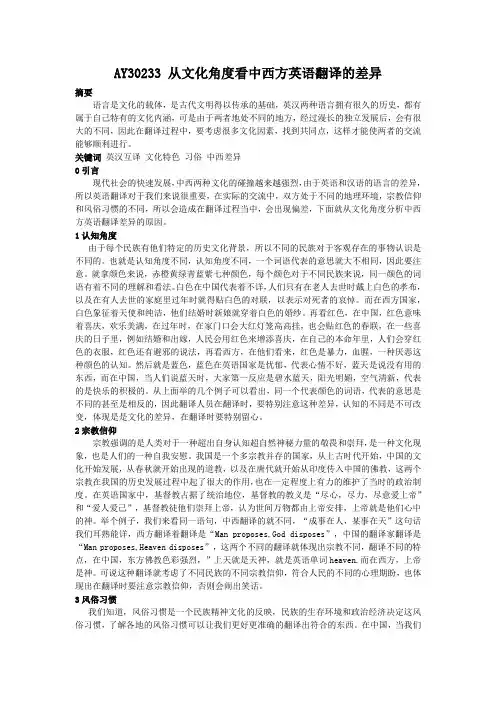
AY30233 从文化角度看中西方英语翻译的差异摘要语言是文化的载体,是古代文明得以传承的基础,英汉两种语言拥有很久的历史,都有属于自己特有的文化内涵,可是由于两者地处不同的地方,经过漫长的独立发展后,会有很大的不同,因此在翻译过程中,要考虑很多文化因素,找到共同点,这样才能使两者的交流能够顺利进行。
关键词英汉互译文化特色习俗中西差异0引言现代社会的快速发展,中西两种文化的碰撞越来越强烈,由于英语和汉语的语言的差异,所以英语翻译对于我们来说很重要,在实际的交流中,双方处于不同的地理环境,宗教信仰和风俗习惯的不同,所以会造成在翻译过程当中,会出现偏差,下面就从文化角度分析中西方英语翻译差异的原因。
1认知角度由于每个民族有他们特定的历史文化背景,所以不同的民族对于客观存在的事物认识是不同的。
也就是认知角度不同,认知角度不同,一个词语代表的意思就大不相同,因此要注意。
就拿颜色来说,赤橙黄绿青蓝紫七种颜色,每个颜色对于不同民族来说,同一颜色的词语有着不同的理解和看法。
白色在中国代表着不详,人们只有在老人去世时戴上白色的孝布,以及在有人去世的家庭里过年时就得贴白色的对联,以表示对死者的哀悼。
而在西方国家,白色象征着天使和纯洁,他们结婚时新娘就穿着白色的婚纱。
再看红色,在中国,红色意味着喜庆,欢乐美满,在过年时,在家门口会大红灯笼高高挂,也会贴红色的春联,在一些喜庆的日子里,例如结婚和出嫁,人民会用红色来增添喜庆,在自己的本命年里,人们会穿红色的衣服,红色还有避邪的说法,再看西方,在他们看来,红色是暴力,血腥,一种厌恶这种颜色的认知。
然后就是蓝色,蓝色在英语国家是忧郁,代表心情不好,蓝天是说没有用的东西,而在中国,当人们说蓝天时,大家第一反应是碧水蓝天,阳光明媚,空气清新,代表的是快乐的积极的。
从上面举的几个例子可以看出,同一个代表颜色的词语,代表的意思是不同的甚至是相反的,因此翻译人员在翻译时,要特别注意这种差异,认知的不同是不可改变,体现是是文化的差异,在翻译时要特别留心。
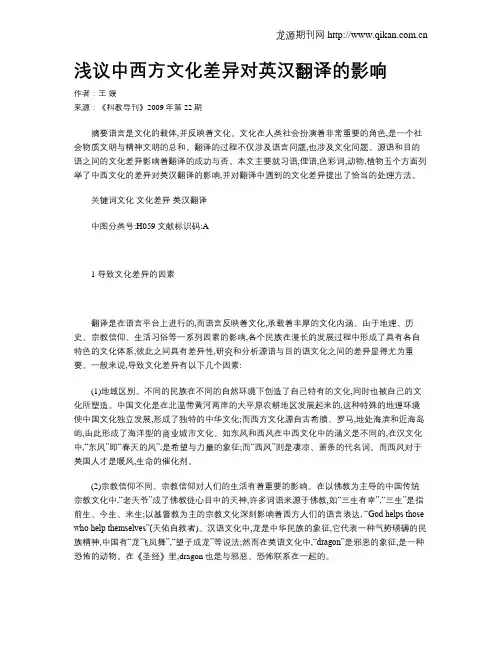
浅议中西方文化差异对英汉翻译的影响作者:王媛来源:《科教导刊》2009年第22期摘要语言是文化的载体,并反映着文化。
文化在人类社会扮演着非常重要的角色,是一个社会物质文明与精神文明的总和。
翻译的过程不仅涉及语言问题,也涉及文化问题。
源语和目的语之间的文化差异影响着翻译的成功与否。
本文主要就习语,俚语,色彩词,动物,植物五个方面列举了中西文化的差异对英汉翻译的影响,并对翻译中遇到的文化差异提出了恰当的处理方法。
关键词文化文化差异英汉翻译中图分类号:H059文献标识码:A1 导致文化差异的因素翻译是在语言平台上进行的,而语言反映着文化,承载着丰厚的文化内涵。
由于地理、历史、宗教信仰、生活习俗等一系列因素的影响,各个民族在漫长的发展过程中形成了具有各自特色的文化体系,彼此之间具有差异性,研究和分析源语与目的语文化之间的差异显得尤为重要。
一般来说,导致文化差异有以下几个因素:(1)地域区别。
不同的民族在不同的自然环境下创造了自己特有的文化,同时也被自己的文化所塑造。
中国文化是在北温带黄河两岸的大平原农耕地区发展起来的,这种特殊的地理环境使中国文化独立发展,形成了独特的中华文化;而西方文化源自古希腊、罗马,地处海滨和近海岛屿,由此形成了海洋型的商业城市文化。
如东风和西风在中西文化中的涵义是不同的,在汉文化中,“东风”即“春天的风”,是希望与力量的象征;而“西风”则是凄凉、萧条的代名词。
而西风对于英国人才是暖风,生命的催化剂。
(2)宗教信仰不同。
宗教信仰对人们的生活有着重要的影响。
在以佛教为主导的中国传统宗教文化中,“老天爷”成了佛教徒心目中的天神,许多词语来源于佛教,如“三生有幸”,“三生”是指前生、今生、来生;以基督教为主的宗教文化深刻影响着西方人们的语言表达, “God helps those who help themselves”(天佑自救者)。
汉语文化中,龙是中华民族的象征,它代表一种气势磅礴的民族精神,中国有“龙飞凤舞”,“望子成龙”等说法;然而在英语文化中,“dragon”是邪恶的象征,是一种恐怖的动物。
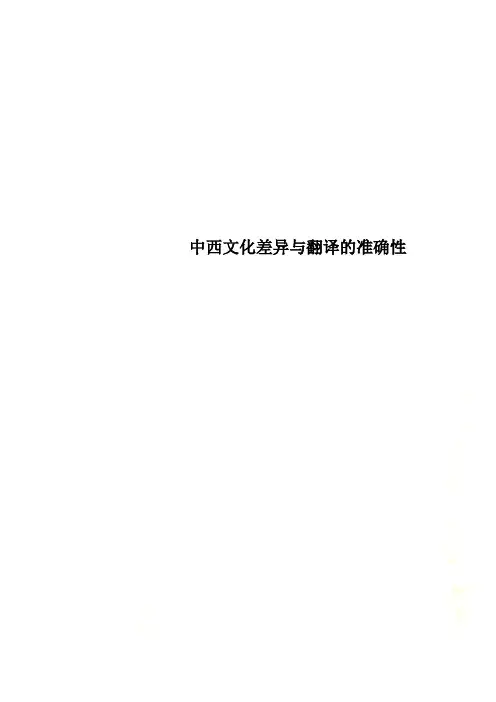
中西文化差异与翻译的准确性“blue films”(黄色影片),“blue software”(黄色软件)等。
而且,英语中的“ yellow boy”不是表示“下流的男孩”,而是“金币”的俗称。
又如,绿色象征万物生长,象征着和平、希望、生机,这在英汉中都是一样的,如:keep the memorygreen(永记不忘),但在英语中green还表示缺乏经验、嫉妒,如green hand(生手),green with envy(十分嫉妒)。
2.动植物文化英汉语中都有着大量的以动植物为喻体的丰富词汇,它们是人类数千年生活经验的总结,语言发达的标志和文明进步的象征。
在翻译时应引起注意。
例如:(4)If he is unhappy with her⋯why doesn’t he leave her? She can be happy without him.It is SOsilly—— this cat—and—dog existence.(T.Dreiser,the Titan)猫狗有时会相互追逐争斗,由此英语短语tO leada cat and dog life含有“像猫狗一样不和,争吵不和的生活”之意,尤其指夫妻之间吵吵闹闹的生活。
了解了这个文化背景,上段话就应该译为:假使他同她在一起并不幸福⋯⋯他为什么不离开她呢?她没有他还可以幸福。
这是多么无聊呀——这种经常吵吵闹闹的生活[s3另外,还有“rain cats and dogs”(下倾盆大雨),“ she is a night owl”(她是夜猫子),“a black sheep”(害群之马)等。
又如,“Jack has fl big mouth and banana.”这句话不可译为“杰克有一张大嘴和一个香蕉”。
在英语中,由于形状相似,banana喻指鹰钩鼻,而用fl sucked orange来比喻“血汗被榨干了的人、被充分利用后不再需要的人。
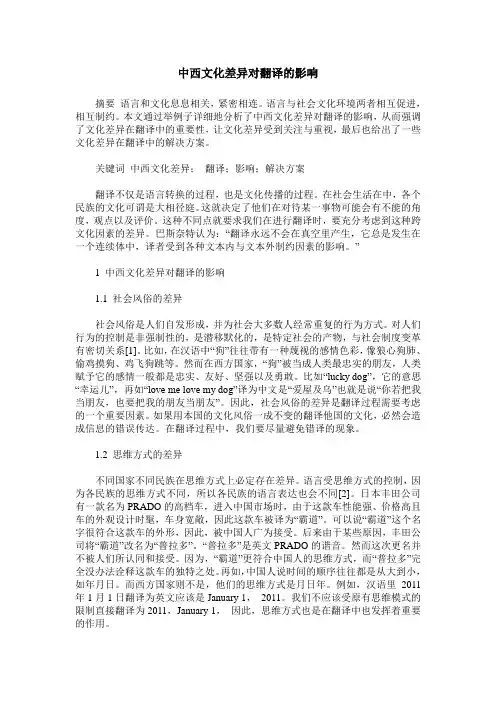
中西文化差异对翻译的影响摘要语言和文化息息相关,紧密相连。
语言与社会文化环境两者相互促进,相互制约。
本文通过举例子详细地分析了中西文化差异对翻译的影响,从而强调了文化差异在翻译中的重要性,让文化差异受到关注与重视,最后也给出了一些文化差异在翻译中的解决方案。
关键词中西文化差异;翻译;影响;解决方案翻译不仅是语言转换的过程,也是文化传播的过程。
在社会生活在中,各个民族的文化可谓是大相径庭。
这就决定了他们在对待某一事物可能会有不能的角度,观点以及评价。
这种不同点就要求我们在进行翻译时,要充分考虑到这种跨文化因素的差异。
巴斯奈特认为:“翻译永远不会在真空里产生,它总是发生在一个连续体中,译者受到各种文本内与文本外制约因素的影响。
”1 中西文化差异对翻译的影响1.1 社会风俗的差异社会风俗是人们自发形成,并为社会大多数人经常重复的行为方式。
对人们行为的控制是非强制性的,是潜移默化的,是特定社会的产物,与社会制度变革有密切关系[1]。
比如,在汉语中“狗”往往带有一种蔑视的感情色彩,像狼心狗肺、偷鸡摸狗、鸡飞狗跳等。
然而在西方国家,“狗”被当成人类最忠实的朋友,人类赋予它的感情一般都是忠实、友好、坚强以及勇敢。
比如“lucky dog”,它的意思“幸运儿”,再如“love me love my dog”译为中文是“爱屋及乌”也就是说“你若把我当朋友,也要把我的朋友当朋友”。
因此,社会风俗的差异是翻译过程需要考虑的一个重要因素。
如果用本国的文化风俗一成不变的翻译他国的文化,必然会造成信息的错误传达。
在翻译过程中,我们要尽量避免错译的现象。
1.2 思维方式的差异不同国家不同民族在思维方式上必定存在差异。
语言受思维方式的控制,因为各民族的思维方式不同,所以各民族的语言表达也会不同[2]。
日本丰田公司有一款名为PRADO的高档车,进入中国市场时,由于这款车性能强、价格高且车的外观设计时髦,车身宽敞,因此这款车被译为“霸道”。
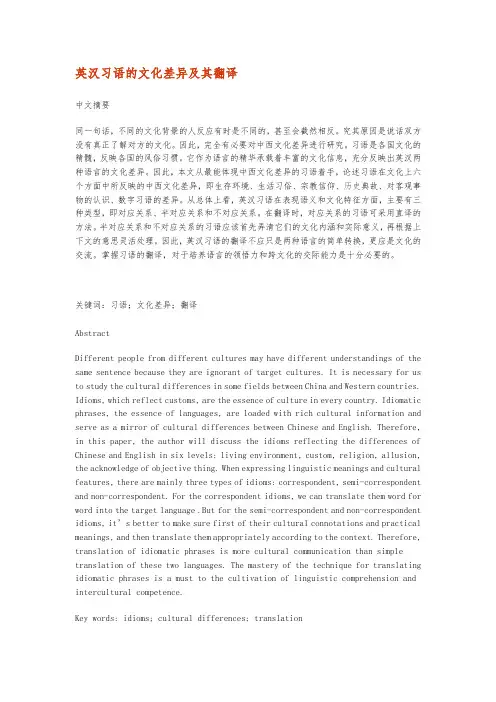
英汉习语的文化差异及其翻译中文摘要同一句话,不同的文化背景的人反应有时是不同的,甚至会截然相反。
究其原因是说话双方没有真正了解对方的文化。
因此,完全有必要对中西文化差异进行研究。
习语是各国文化的精髓,反映各国的风俗习惯。
它作为语言的精华承载着丰富的文化信息,充分反映出英汉两种语言的文化差异。
因此,本文从最能体现中西文化差异的习语着手,论述习语在文化上六个方面中所反映的中西文化差异,即生存环境、生活习俗、宗教信仰、历史典故、对客观事物的认识、数字习语的差异。
从总体上看,英汉习语在表现语义和文化特征方面,主要有三种类型,即对应关系、半对应关系和不对应关系。
在翻译时,对应关系的习语可采用直译的方法。
半对应关系和不对应关系的习语应该首先弄清它们的文化内涵和实际意义,再根据上下文的意思灵活处理。
因此,英汉习语的翻译不应只是两种语言的简单转换,更应是文化的交流。
掌握习语的翻译,对于培养语言的领悟力和跨文化的交际能力是十分必要的。
关键词:习语;文化差异;翻译AbstractDifferent people from different cultures may have different understandings of the same sentence because they are ignorant of target cultures. It is necessary for us to study the cultural differences in some fields between China and Western countries. Idioms, which reflect customs, are the essence of culture in every country. Idiomatic phrases, the essence of languages, are loaded with rich cultural information and serve as a mirror of cultural differences between Chinese and English. Therefore, in this paper, the author will discuss the idioms reflecting the differences of Chinese and English in six levels: living environment, custom, religion, allusion, the acknowledge of objective thing. When expressing linguistic meanings and cultural features, there are mainly three types of idioms: correspondent, semi-correspondent and non-correspondent. For the correspondent idioms, we can translate them word for word into the target language .But for the semi-correspondent and non-correspondent idioms, it’s better to make sure first of their cultural connotat ions and practical meanings, and then translate them appropriately according to the context. Therefore, translation of idiomatic phrases is more cultural communication than simple translation of these two languages. The mastery of the technique for translating idiomatic phrases is a must to the cultivation of linguistic comprehension and intercultural competence.Key words: idioms; cultural differences; translation语言承载着丰富的文化内涵,而作为语言精华的习语更是如此。
浅析中西方文化差异与英语翻译论文无论是在学习还是在工作中,大家都经常接触到论文吧,通过论文写作可以培养我们独立思考和创新的能力。
相信很多朋友都对写论文感到非常苦恼吧,下面是店铺精心整理的浅析中西方文化差异与英语翻译论文,欢迎大家借鉴与参考,希望对大家有所帮助!浅析中西方文化差异与英语翻译论文篇1摘要:翻译的本质是两种文化的交流。
文化的差异是一个译者必须要处理好的问题,如果处理不当就容易让读者产生歧义。
分析了中西方主要的文化差异,并对主要的差异进行了举例说明。
介绍了对于这种差异的基本翻译方法,它们分别是:异化法、归化法和音译法。
并对这些方法进行了解释。
关键词:文化差异;处理方法;异化法;归化法;音译法1、语言是社会的产物,是人类历史和文化的结晶它凝聚着一个民族世代相传的社会意识,历史文化,风俗习惯等各方面人类社会所有的特征。
不同的文化需要沟通。
沟通离不开翻译,可见文化及其交流是翻译发生的本源,翻译是文化交流的产物。
翻译教学和研究的经验表明:翻译理论和技巧必须建立在不同语言和文化的对比分析的基础上。
翻译之所以困难,归根结底是语言差异和文化差异。
英汉两种语言在表达方式上有相似之处,但2012年02月13日09时09分,《英语学习:英语论文:简析中西方文化差异与英语翻译[1]》由出国英语编辑整理。
2、译法汉语文化中特有的事物在英语文化中完全空缺,这时可采用音译法将具有特殊文化内涵的词语“移植”到英语文化中去。
如:“功夫”kong fu、“乌龙茶”oolong等。
许多采用音译法翻译的词语已成为英语中的外来词,被西方大众广泛接受。
3、结语语言是文化的一部分,也是文化的传承者。
文化依靠语言进行传播、交流。
东西方文化的差异对英汉互译产生了深远的影响。
因此对于译者来说熟悉中英两种文化甚至比掌握这两种语言更为重要。
翻译离不开文化,没有基于文化的翻译是达不到交流的目的的。
本文只列举了三种基本的翻译方法,对于文化意象处理的问题,并没有统一的翻译方法和公式,译者应根据上下文灵活处理。
中外文化差异的英语作文带翻译篇一:中西方文化差异英语作文In my view, it is not surprising that Mr. Jones and Mr. Wang had a so unpleasant conversation, because it caused by the different culture between East and West.Modesty is one of the national characters of Chinese people, which can be proved by those stories about modesty in the history of China. When praised in public, the Chinese may deny it to show the modesty, though he is happy to hear that. However, the Westerner may just say “thank you”to express happiness.If I were Mr. Wang, I would say “Thank you for your praise, and I will keep working hard to do better”. As far as I am concerned, excessive modesty is just hubris, so we should receive the praise with happiness and do better.If I were the boss, I would study the different culture more to understand the staff. As the old saying goes, do in Rome as Rome does. So only if the boss know the difference in the culture and do the right things, can he motivate the staff more appropriately to make more money.篇二:中西文化差异比较(英文)The difference between chinese and western cultureWith the rapidly challging word, people throughout the world have found it increasingly necessary to minimize the rate of misunderstanding due to miscommunication in their contacts with another. In the oast most human beings were born, lived, and died within a limited geoographical area, never encountering people of other cultural backgrounds. It might be said that technological advances have been most effective in creating the borderless word, the global community. As our world shrinks and its inhabitants become interdependent, people from remot cultures increasingly come into contact on a daily basis. It is no longer hard to find situations in which membes of ince isolared groups of people. Now these people may live thousands of miles away or right next door to each other. So all the people are faced with the challenge of understand this world. So when the east meet west, there are many problems. Some problems are listed as follows.First of all, the way of eating. All huaman beings have certain basic needs. Our fundamental needs for things that keep us alive. This is the physioligical need. All individuals must eat in order to survive. But what people eat, when they eat, and the manners in which they eat are all patterned by culture. No society views everything in its environment that is edible and might providenurishment as food. Americans eat oysters but not snail. The French eat snails but not locusts. The Jews eat fish but not pork. The Hindus eat pork but not beef. The Russiand eat beef but not snake. We all have ideas about what kinds of food are good to eat. We also have ideas about what kinds of food are bad to eat. As a result, people from one culture often think the food that people from another culture eat are disgusting or nauseating. Dislike is not the only reason why some culture will not eat a certain food. In some clture, certain foods are taboo. Sometimes the food taboos may be so strong thrat just the thought of eating forbidden foods can cause an indivdual to feel ill. We can also find culture difference in way of bring up children treating the early, greeting each other, saying and spending money before other people do in everyday, but in some English-speaking countries, people do not agree with us. We chinese may enjoy something that is not usually consider as edible by the English-speaking people. Generally we perfer to have thing hot and much emphasis on the taste. We eat from one plate when we are eating with others, and we like to seat one by one, and in the shape of a round. On the opposite, some English-speaking contries, most of the people like to seat in two rows, two people face to face. They have their own plate. On the aspect of table manners, there are many differences between chinese and English-speaking people. Forexample, in some Englishi-speaking countries, Bread plates are to the left of the main plate, beverage glasses are to the right. Salad fork, knife and soup spoon are further from themain plate than the main course knife, fork and spoon. When eating bread rolls, break off a piece before buttering. Use the knife only to butter the bread, not to cut it. They should not start eating before your host does or instructs to do so. At larger meals, it is considered okay to start eating once others have been served. When finished, place the knife and fork together at five o’clock with the fork on the left. It is considered rude to answer the telephone at the table. If need to take an urgent call, excuse self and go outside. Try to eat all the food you are served. But in China, the table manners are different. Chinese traditionally eat rice from a small bowl held in the left hand. The rice bowl is raised to the mouth and the rice pushed into the mouth using the chopsticks. Some Chinese find it offensive to scoop rice from the bowl using a spoon. If rice is served on a plate, as is more common in the West, it is acceptable and more practical to eat it with a fork or spoon. The thumb must always be above the edge of the bowl. The host should always make sure the guests drinks are sufficiently full. One should not pour for ones self, but should offer to pour for a neighbor. When your drink is being poured, you should say "thank youand tapfingers on the table to show appreciation. When people wish to clink drinks together in the form of a cheer, it is important to observe that younger members should clink the edge of their drink below the edge of an elder to show respect.Secondly, the way of communication. Form birth to death, communication plays an integral part in our life. There are some language problems, including the different styles of using language such as direct, indirect; expansive, succinct; argumentative, conciliatory; instrumental, harmonnizing; and so on. These different styles can lead to wrong interpretations of intent and evaluation of insincerity, aggreeiveness, deviousness, or arrogance, among other. The misinterpretation nonverbal signs and symbols such as gestures, postures, and other body movements. It is a definite communication barrier. But it is possible to learn the meanings of these observable message,usually in informal rather ways. It is more difficult to understand the less obvious unspoken codes of the other cultures. Language, as the carrier of culture, is created during the process of human beings’productive labor and serves as the tool of communication to convey the message between people. However, it has been endowed with magic and power in particular language acts. As the old saying goes, troubles come out of the tongue. Superstitious people think that the language itself can bring aboutfortune or misfortune so that taboos to restrict the use of language are created. Anyone who violates them will get punishment, whereas those who faithfully obey the restrictions of language taboo will get protection. Furthermore, linguistic taboos change with the development of society .The paper firstly analyzes the evolution of linguistic taboo. It is indicated in the paper that linguistic taboo exists in almost every aspect of people’s life and is a universal social phenomenon in China and Britain. Both Chinese andEnglish cultures are in agreement about linguistic taboos such as pronunciation taboo, and vocabulary taboo. However, influenced by different cultural backgrounds, ideologies and the concepts of value, Chinese and English linguistic taboos also have differences, as is discussed in the paper from the aspects of taboo subjects, taboo numbers and names. At last, this paper puts forward two effective ways of avoiding taboo, that is, using euphemism and having a good knowledge of the taboo culture. And this discussion would help English learners improve their ability of cross-cultural communication and achieve better communicational effects. For example, During the feudal times, people were not equal to the rulers and were suppressed by their superiors. The distinction between the upper and the lower classes was also reflected in theevaluation of the language used by them respectively. The words of upper class used were considered good and elegant while those used by the lower class were regarded as vulgar and indecent and should be avoided in the speech of ladies and gentlemen. In modern society, as a result of the development of science and technology, many natural phenomena are no longer mysterious. Human beings not only constantly improve their abilities to exploit the world where they are living through their great wisdom and knowledge, but also make efforts to explore the extraterrestrial world. Science has much more say in today’s society. Thereby, the superstitious elements in linguistic taboos decrease while those reflecting spiritual civilization increase.In short, by comparison, we can find that both Chinese and English communication reflect people’s psychology for good will, for safety and fortune and pleasantness. The Chinese and English people restrict their words and deeds through taboos, trying to keep a harmonious relationship between human and nature, or between people and society. They are a reflection of people’s pursuit of freedom and equality.The most important, the different way of family structure, family values and family education. Family structure is the big difference between east and west, traditional chinese, amony manyother Asians, repect their elders and feel a deep sense of duty toward them. Children repay their parents` sacrifices by being successful and supporting them in old age. This is accepted as a natural part of life in China. In contrast, taking care of aged parents is often viewed as a tremendous burden in the English-speaking countries, where aging and family support are not honored highly. In some English-speaking countries are still extrmely family-oriented. They are dedicated to helping their children and will sacrifice(转自: 千叶帆文摘:中外文化差异的英语作文带翻译) greatly for their children to get an edcuation. In turn, the children are devoted to their parents, who often live nearby. Grown children who go away and leave the country for the economic reasons typically send large parts of their salary home to their parents and the rest of the family. Or in some Asia, any decisions or actions are done from family consideration, not individual desires. Peope`s behavior is judged on whether itbrings shame or pride to the family. The children are trained to rely on their families, to honor elderly people, and to fear foreigners. And many of them think that their actions in this life will influence their status in the next life.The way of family edcation is also the different. We all know the family education is the elementary education for children. Manyserious problems have appeared in our education system in recent years. Almost everyone has realized the importance of solving these problems and many people have presented a lot of valuable suggestions. There are many types of family education in the world and each of them shows distinctive features and is closely responsive to its culture. And American family education is the most famous one among them. There are great differences in the concepts of education, methods of education and results of education between East family education and West family education. In some English-speaking countries, parents’aims are to train their children to have the ability of adapting to environmental variety and the ability of living independently. Based on this concept, most American parents emphasize more to train their children’s ability of independence once they are born. They generally believe that children’s growth must rely on their own experiences, because they think that children should form a self-supporting will and the capacity to live independently since their childhood. And the capacity comes from the training in the early age. The so-called training contains many aspects, such as work, temper will, patience, the spirit of hard work, etc. However, the most fundamental training is the ability of adapting to hard conditions. Through the process of work, children will form thelabor sense, learn some work skills and form a habit of labor. Besides, children can learn how to overcome difficulties, temper their willpower, develop their talents and skills, rich their knowledge, and form a habit of hard work and thrifty by working in hard conditions. It is just in the unconsciously process that children will obtain the independent survivability and take the responsibilities for the society. Compared with some English-speaking countries, Chinese parents have a very different concept of children’s education. Some parents in China only care about whether the children have a promising future, a good job, a good life or not. Based on these expectations, the majority of parents feel that their responsibility for their children is to create as good conditions as possible they can so that the children will not worry about anything in the future. Chinese parents would like to provide everything what they can for their children in the process of children’s growth. In short, they would like to sacrifice anything if their children can live better with their help. Therefore, in the process of children’s growth, the most important thing the parents concerning is to developing their children’s intellect, except for caring children’s daily life. In order to make their children have a good performance in study, become outstanding, or even become a famous person in the future, they would not let children doanything except studying. As for the children’s independence, civic awareness and their ability adapting to thesociety in the future, they consider little or not at all. From these aspects we can find the obvious differences of family education between America and China.When we faced with those difference between West and East, we should give some advice to solve these problems. According to the three big difference that pointed, we should find some way to deal with these problems.We can study other languages and learn to expect in nonvwebal forms and other cultural aspects. We can train ourselves to meet intercultural encounters with more attention to situation details. We can use an investigative approach rather than stereotypes and preconceptions. We can gradually expose ourselves to differences so that they become less threatening. We can even learn to lower our tension level when needed to advoid triggering defensive reactions. The overall goal should be to achieve intercultural communication competence.So the ideal solution to reduce the problems are to share knowledge with others in communication. This is why it is easiest to communicate with other members of the same group. This is why people so often gather together socially with others who are verymuch like them. Since intercultural communication is communication with members of different cultual groups, and therefore, because we do not share knowledge, assumptions, values, and forms of discourse with them, we must expect there to be problems of interpretation. We must look for these problems, anticipate where they will arise out of our differences, and then plan our aommunications to be as effective as possible. However, we have to remember that, most of the time, the different ways that are the customs of dfferent cultures are neither right nor wrong. It is simply that different people do the same tings in different manners, even though we can not understand ,we should show the respect. I believe this is the best way to make our life become more comfortable and make the world more harmonious.篇三:英语作文-东西方文化差异-Cultural differencesCultural differencesThere are plenty of. people in the world. They come from different countried, have theirown race, belief and way of life. What is more, their culture is different from others'. So,there is no doubt that cultural difference exist among lots of countries, especially betweeneastern and western countries.Compared with the way of life, eastern people always have a bath in the evening or atnight in order to relax themselves after one-day's hard work while western people take abath in the morning. so as to keep freshly for the whole day. In general, it is true,especially for Chinese people. We, Chinese people would like to take baths at night ratherthan in the morning. It is a kind of habits we behave all the time.Compared with the relationships, differences are as follow: firstly, eastern people like tomake friends, sometimes through their friends, parents, relatives. While western peoplebehave a little shyly. They do not want to make friends all the time. Secondly, easternpeople would like to hang out with the person they do not know about quite a lot. whilewestern people just like going out with the person whom they get along well with.Finally, eastern people have much more friends than western people for their quitedifferent way of getting along with. their friends. There is no doubt that eastern peopleare more outgoing than western people, so I agree with these a lot.As for way of solving problems, eastern people always deal with things indirectly. Theypay much attention to many things around them, and always work for a long time to solvethe problem. However, western people just go straight the heart of the problem and solveit directly and efficiently. As far as I am concerned, this difference between eastern andwestern people is quite normal and correct. Eastern people, especially Chinese peoplecare about things around them a lot, they always want to satisfy everyone's need, so thatthey spend much more time to solve a problem than western people.As for way of thinking, people in eastern areas usually think indirectly. They used tothink about the things around them a lot and try to deal with things in a reasonable evenperfect way. However, in comparison with the eastern people,people in the western areasoften think directly. They pay less attention to the things around them and care muchmore about themselves. Honestly speaking, I disagree to this.In my opinion, everyone isspecial and has their right and obligations to do things. There is no need for us to critiseothers and what we should do is to respect their own. decision.There are a lot of differences between eastern and western culture. These are the symbolsof their own characteristics and we need time to dig out more differences so as to learnmore about them. Most importantly, we must respect their culture firstly!。
关于中西方文化差异的英语作文_高考满分英语作文4篇关于”中西方文化差异“的英语作文模板4篇,作文题目:Cultural differences between China and the West。
以下是关于中西方文化差异的高考英语模板,每篇作文均为满分模板带翻译。
高分英语作文1:Cultural differences between China and the WestWestern students enjoy a seemingly relaxed educational experience, but Asian students are not. They face heavy workload and are often very self disciplined in the first stage of globalization. China's standardized examination has a long history.The ancient imperial examination began in the Sui Dynasty. Shanghai foreign language school is one of the best middle schools in Shanghai. Her English is nearly fluent.She is studying German, and her physics scores are among the best. Her goal is to receive a full scholarship from Harvard University to study biochemistry. It's not just Western expatriates who hear about British students like shellyth, politicians, parents and pundits worried that the diligence and discipline of Eastern children has left the relatively relaxed Westerners behind.中文翻译:西方学生享受着看似轻松的教育体验,但亚洲的学生却并非如此,他们面临着繁重的工作量,而且在全球化的第一阶段往往非常自律。
中西文化差异导致的翻译错误注:以下所找案例均为在不了解文化背景情况下直译出现的错误。
动物:1、白象译为White Elephant白象就是白色的亚洲象,在古代暹罗国(今泰国)盛产大象,白色的象是非常稀少的,所以被视为珍宝,一般的大象可以用来劳动,但是白象只能用来供养,不能劳动,科学家已经证明白象不是象的品种,而是一般的象得了白化病。
但是大象如果不劳动的话,花销很大,即使是泰国的一般的贵族也养不起的,如果泰国国王对那个臣下不满就送他一头白象,既是宝物又是御赐,那么大臣就的更好的供奉白象,于是家道很快就衰落了。
后来英语就把白象(white elephant) 称为昂贵而无用的东西的代名词。
2、龙译为Dragon在西方国家的神话中Dragon是一种形似蜥蜴,能喷火,替魔鬼看守财物的怪物。
在基督教文化里则被形容是邪恶、恶魔的代名词。
现如今,西方民间对龙的看法早已脱离了绝对的邪恶以及凶猛的野兽,更多的则是一种拥有力量的中立生物。
但基督教文化还是西方文化的主流,Dragon在主流文化上还是恶魔的代名词。
凶暴的女人亦被称为“dragon”例如:She is a real dragon.(她真是一个母夜叉。
)批评希特勒之类恶魔,政治文章还是称之为Dragon。
在中国龙则是尊贵、威严的象征。
封建社会的皇帝经常自称为“真龙天子”。
还有很多关于龙的成语如:龙凤呈祥、生龙活虎。
3、孔雀译为Peacock中国人认为孔雀开屏是喜庆吉祥的象征,所以人们常用孔雀比喻美丽的人或事物。
但是孔雀在西方的身价却一落千丈。
西方人认为孔雀行走时昂首阔步、目中无人,头冠频频摆动,还不时开屏来炫耀其美丽,这是"骄傲"、"虚荣"的表现。
The American Heritage Dictionary对peacock的第二个解释为:a vain person given to self-display, dandy (—个虚荣的、自我表现的人,爱穿着打扮的男人)。
第4讲中西小说比较与翻译中文化因素的处理(一)上一节我们讨论了文化因素,即文化词和三个类型的文化含义词在翻译中语际转换时一般的处理方式。
本讲将结合小说翻译进一步分析和讨论小文化,及文化因素的处理问题。
1.童养媳在西方社会是没有这种现象的,因此在英语中也没有与它对等的词。
请看赵树理小说《小二黑结婚》中几个“童养媳”的处理方式。
(1)……有个老李带来个八九岁的小姑娘,因为没有吃的,愿意把姑娘送给人家逃个活命。
二诸葛……就替小二黑收作童养媳。
(2)村里谁不知道小二黑不承认他的童养媳。
(3)二诸葛家里除了童养媳之外,三个人谁也没有睡。
(4)问:“你给小二黑收了个童养媳?”(5)回去吧!童养媳没处退就算成你的闺女!译文:(略)以上种种处理,都是“little girl”为基本词,在根据上下文加些适当的词语加以解释,“童养媳”的文化含义必须通过整个句子才能给以传达。
2.媳妇“媳妇”这个词在汉语中可以指“儿子的妻子”,“晚辈亲属的妻子”,也可指“妻子”。
“新媳妇”也可指新婚的儿子的妻子或妻子或新娘子,概念差一代。
在汉译英时,往往要根据不同情况作不同的处理。
(1)于富的娘早死了,只有个爹,父子两个一上了地,家里只留下新媳妇一个人。
(于富的妻子)(《小二黑结婚》)(2)于富他爹看见不像个样子,有一天发了脾气,大妈一顿,虽然把外人挡住了,新媳妇却跟他闹起来了。
……哭了一天一夜。
(是于富他爹的儿媳妇)(《小二黑结婚》)(3)林妹妹早就知道了,他如今要做新媳妇了。
自然害羞,不肯见你的。
(新娘)(《红楼梦》)(4)你如今做媳妇了,我才告诉你:这如今你林妹妹没了两三天了。
(妻子)(《红楼梦》)(5)老太太和姑妈打量是那里的笑话儿?就是咋们家的那二位姑爷新媳妇啊!(新郎新娘)(红楼梦)译文:(略)3.亲属词亲属词(kinship term),我们在第2和第3讲也已介绍过。
它属于A类文化含义词。
这也是翻译中经常遇到的难题之一,一般采用替代、释义(定义)、换一个角度说明的办法来处理。
(1)宝玉……拉着手哭道:“我问你:宝姐姐怎么来着?我记得老爷给我娶了林妹妹过来,怎么叫宝姐姐赶出去了?……”(《红楼梦》)译文:(略)(2)凤姐姐说道:“刚才我到宝兄弟屋里,我听见好几个人笑。
我只道是谁,巴着窗户眼儿一瞧,原来宝妹妹坐在炕沿上,宝兄弟站在地下。
宝兄弟拉着宝妹妹的袖子,口口声声只叫:‘宝姐姐!你为什么不说话?’”译文1:(略)译文2:(略)英语中brother、sisiter两个词长幼之分,而汉语中姐姐、妹妹、哥哥、弟弟分得很清。
《红楼梦》中不断出现大量的宝哥哥、宝兄弟、宝姐姐、宝妹妹、林妹妹,如果都要认真地分清长幼,西方读者肯定会不胜负担。
但一概说brother, sister有可能分不清谁是谁。
两种译文都想到了一个非常好的替代办法,就是用cousin加个姓,或加个名来区别他们,尽管有时他们之间的关系并非都是cousin,如熙凤与宝玉并非cousin,而是in-law。
(3)袭人握了自己的嘴,笑的说不出话来,半日才说道:“那是新娶的二奶奶。
”……宝玉道:“好糊涂!你说的‘二奶奶’,到底是谁?”袭人道:“宝姑娘。
”(同上)译文1:(略)译文2:(略)袭人是个丫头,低人一等,所以称宝玉的妻子为“二奶奶”。
如果仿译为The Second Granny (或grandmother), 译语读者不了解这个风俗习惯会感到十分惊讶,不解其意。
这里只有用替代和解释的办法才行。
(4)行者道:“嫂嫂修得推辞,我再送你个点心充饥!”又把头往上一顶。
那罗刹心痛难禁,只在地上打滚,疼得他面黄唇白,只叫“孙叔叔饶命!”行者才收了手脚道:“你才认得叔叔么?我看牛大哥情上,且饶你性命!”(西游记)译文1:(略)译文2:(略)按照我们的风俗习惯,对丈夫的兄弟,妻子要称“叔叔”以显示尊敬。
如果译成uncle 也同样会使西方人迷惑不解,因此也只能用brother或brother-in-law来替代。
(5)贾母……说:“你替我告诉他(指林黛玉)的阴谋:‘并不是我忍心不来送你,只为有了个亲疏。
你是我的外孙女儿,是亲的了;若于宝玉比起来,可是宝玉比你更亲些。
’”(《红楼梦》)译文1:(略)译文2:(略)由于汉人的习俗,孙子辈有内外之分,父系为内,母系为外。
内亲和外亲在一般场合用一个grandson或granddaughter都可以指代了,不必细分。
但在这段文字中,贾母要严格区分亲疏,区别孙子与外孙的不同,所以在译文中一定要清楚交代这一层关系。
在译文1中对外孙女做了定义性的解释:daughter’s daughter,但究竟问什么宝玉比黛玉更亲,没有交代清楚。
在译文2中,译者深怕西方读者仍然不动其中的理由,顾又加了一句:“Bao-yu is a jia”以显示其直系性。
(6)凤姐说,“明儿宝玉圆了房儿,亲家太太抱了外孙子,那时候儿不是更笑话了么?”(同上)译文1:His-feng said, “Soon Pao-yu will have consummated his marriage, and then Aunt Hsueh will have a grandson to dandle—won’t that be a still better joke?” (杨宪益等)译文2:“Soon there will be no lack of them,”replied XI-feng. “When their marriage is consummated, and Bao-yu presents his mother-in-law with a grandchild…” (John Mindford) 英语中没有与“亲家”对等或近似的词。
在译文1中用Aunt Hsueh来替代,译文2中换了个角度解释宝玉的mother-in-law。
(7)他本想早给小芹找个婆家推出门去,… (《小二黑结婚》)She had long intended to find a husband for Little Qin and thus get rid of her.“婆家”英语中也无对等的词和近似的词,只能换个角度解释称to find a husband。
4.乐器的处理方法不久人们的视线都集中到一个小小的行李卷上,那上面插着用漂亮的白绸子包起来的南胡、箫、笛,旁边还放着整洁的琵琶、月琴、竹笙,……这是贩卖乐器的吗?…… (《青春之歌》)译文:Before long the attention of quite a few was caught by some unusual luggage: a small bedding-roll to which were tied a fiddle, a bamboo pipe and a flute, each wrapped in fine white silk. Nearby was a balloon guitar, a moon-guitar and a small reed-organ. …Some passengers surmised that these must belong to dealer in musical instrument.文中提到的六件乐器都是中国特有的乐器。
处理的方法:(1)用西方相似的乐器名替代:南胡—fiddle(提琴),笛—flute(西方交响乐中的横笛);(2)以形状描述加相似的乐器名:琵琶—balloon guitar(气球形状,椭圆状吉他);(3)以制作材料加相似的乐器名:箫—bamboo pipe,竹笙—small reed organ;(4)仿译:月琴—moon-guitar (guitar也是替代)。
5.服装,各民族各具特色,处理起来也是方法多样(1)夏天,他穿着纺绸大褂或者竹布大褂、千层底布鞋;冬天是绸子棉袍外面套上一件蓝布大褂,头上是一顶宽边礼帽,脚底下竟穿起了又肥又厚像小船一样的“老头靴”。
(《青春之歌》)译文:(略)这些服装都歌剧民族特色,用近似词替代和描述解释定义的办法处理。
如大褂、袍子都用gown,替代再加以描述;千层底—thick-soled cloth slippers可以说是定义;老头靴—boots usually worn by elderly men就是释义了。
(2)他穿着一件灰布中山装,戴着半旧的灰呢帽。
(《青春之歌》)译文:(略)(3) 身上是谈青色的印花的华尔纱长旗袍,深黄色绸的里子,开叉极高。
(《子夜》)译文:(略)(4) 这女学生穿着白羊布短旗袍、白线袜、白运动鞋。
(《青春之歌》)译文:(略)“旗袍”是中国特有的服装。
在上面两句的译文中都用了相似词来替代。
句(3)用dress,句(4)用gown。
(5)所以他便赶紧拔起四个萝卜,拧下青叶,兜在大襟里。
(《阿Q正传》)译文:(略)“大襟”是指上衣和袍子的前面部分,这里用jacket替代,实际上想去深远。
但是因这个句子中并非十分必要说清“大襟”是什么样的衣服的什么部分,用jacket文字简洁,也是比较可行的。
(6)穿的是新夹袄,看去腰间还挂着一个大褡裢。
(《阿Q正传》)译文:(略)(7) 现在虽然明知道啊Q,但因为和破夹袄的阿Q有些两样了。
(同上)译文:(略)同样是“夹袄”,并在同一段文字里,而在译文里用了两个替代词jacket和coat。
(8)许多长衫和短衫人物,忽然给他穿上一件洋布的白背心,上面有些黑字。
(同上)译文:(略)6. 由于汉语言文字的特点而引发与包涵的文化含义,是语际转换时最难处理的难点。
一般只能用音译、替代和解释来处理,有时可以同时加注以帮助读者了解其含义。
(1)我曾经仔细想:阿Quei, 阿桂还是阿贵呢?倘使他号叫月亭,或者在八月间做过生日,那一定是阿桂了;而他既没有号——也许有号,只是没有人知道他,——又未尝做过生日征文的帖子:写作阿桂是武断的,又倘若他有一位老兄或令弟叫阿福,那一定是阿贵了;而他又只是一个人:写作阿贵,也没有佐证的。
(《阿Q正传》)译文:(略)汉字“桂”与“贵”同音,究竟是阿桂还是阿贵,涉及到这两个字的含义以及有关的风俗习惯。
译者用音译加注释的办法来解决这个问题。
但为什么“桂”与“月亭”、与“八月”相联系。
“贵”又与“富”相联系,这层文化含义译文中并没有交代。
(2)最恼人的是在他头皮上,颇有几处不知起于何时的癞疮疤。
这虽然也在他身上,而看阿Q的意思,倒也似乎以为不足为贵的,因为他讳说“癞”,以及一切近乎“癞”的音,后来推而广之,“光”也讳,“亮”也讳,再后来,连“灯”、“烛”都讳了。
译文:(略)这段文字中有两点要处理好。
一个是“癞”与“赖”同音词,译者用了any words that sounded anything like it做了解释;第二个是为什么“癞”与“光”、“亮”、“灯”、“烛”扯到一起,这是因为民间把发亮的癞疮疤戏谑地比作发亮的灯的缘故。